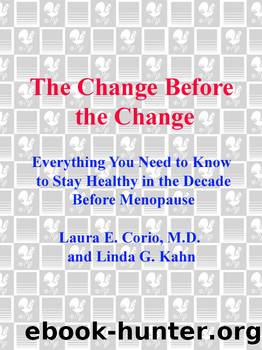The Change Before the Change by Laura Corio

Author:Laura Corio [Corio, Laura E.]
Language: eng
Format: epub
ISBN: 978-0-307-83043-2
Publisher: Random House Publishing Group
Published: 2013-04-10T00:00:00+00:00
ESTROGEN: THE HEART OF THE MATTER
My mother has this old saying, âMen work from sun to sun, but womenâs work is never done.â The same could be said of the estrogen your body produces naturally. In addition to controlling our reproductive functions, keeping our brains and bones healthy, giving us beautiful skin and hair, and helping to regulate our metabolism, it influences just about every aspect of our cardiovascular systemâquite a job! This makes perfect sense in evolutionary terms: it wouldnât be too smart for Mother Nature to have us dying of heart attacks during our prime childbearing years. Sheâs a fickle friend, however. Once we can no longer be of service to her by perpetuating the species, it seems she could care less what happens to us.
But we do care. Understanding exactly how estrogen affects your heart, blood vessels, and blood will help you focus your energies on compensating for your declining levels of this essential hormone through diet, exercise, vitamins and minerals, and, if desired, hormone supplements.
How does estrogen benefit your heart and circulation? Two-thirds of estrogenâs protective effect is a result of direct action on the vascular system. As I explained in earlier chapters, there are estrogen receptors on the surfaces of blood vessels. In the presence of estrogen, blood vessels dilate; in the absence of estrogen, they constrict.
When your blood vessels constrict, your blood pressure rises, damaging the linings of the vessels. When the lining of a blood vessel is scraped or roughed up, blood flow over that spot slows down and it becomes a magnet for fatty deposits, or plaques. Plaque buildup hardens and further narrows the lumen, or interior of the blood vessel. When the lumen is constricted, the blood (heart) has to pump harder to force its way through, leading to even higher blood pressure. A narrowed artery also becomes a trap where clots can form. Furthermore, chunks of plaque can break off and cause a heart attack or strokeâone of the leading causes of sudden death in perimenopausal women.
Blood vessel linings are also damaged by the oxidized form of LDL cholesterol. The damaged walls not only make the vessel inflamed and vulnerable to atherosclerosis, but also produce less of the vasodilating and anticlotting agents nitric oxide and prostacyclin. Estrogen stimulates the release of nitric oxide, thereby keeping the blood vessels supple. Estrogen is also a powerful antioxidant, soaking up dangerous free radicals produced when LDL cholesterol is oxidized, thereby protecting the vessel walls from damage and reducing the risk of blood clots. Two other ways in which estrogen prevents blood clotting are by making plateletsâthe cells responsible for forming blood clotsâless sticky and by decreasing levels of fibrinogen, an important clotting factor.
Estrogen relaxes not only blood vessels but the walls of the heart itself. When women are treated with estrogen, the pumping, or contractibility, of their left ventricle improves. The heart can therefore take in more blood with each beat, improving circulation overall and decreasing the risk of heart failure.
The remaining third of estrogenâs beneficial effect comes from its influence on lipid metabolism.
Download
This site does not store any files on its server. We only index and link to content provided by other sites. Please contact the content providers to delete copyright contents if any and email us, we'll remove relevant links or contents immediately.
| Breast Cancer | Candida |
| Chronic Fatigue Syndrome & Fibromyalgia | Endometriosis |
| General | Lupus |
| Menopause | Menstruation |
| Postpartum Depression | Pregnancy & Childbirth |
| Sexual Health |
Name Book, The: Over 10,000 Names--Their Meanings, Origins, and Spiritual Significance by Astoria Dorothy(2940)
Tone Your Tummy Type by Denise Austin(2789)
The Ultimate Guide to Anal Sex for Women by Tristan Taormino(2244)
The Coregasm Workout by Debby Herbenick(2221)
The Expectant Father by Armin A. Brott & Jennifer Ash(2219)
The Women's Health Fitness Fix by Jen Ator(2202)
Expecting Better by Emily Oster(2160)
She-ology by Sherry A. Ross MD(2133)
The Hite Report on Shere Hite by Shere Hite(2025)
Woman: An Intimate Geography by Natalie Angier(1884)
8 Steps to Reverse Your PCOS by Fiona McCulloch(1872)
Birth by Tina Cassidy(1866)
The Female Brain by M.D. Louann Brizendine(1858)
101 Get-Lean Workouts and Strategies by Muscle & Fitness(1808)
Women & the Weight Loss Tamasha by Diwekar Rujuta(1766)
50 Ways to Soothe Yourself Without Food by Susan Albers(1745)
The Big Booty Blueprint: Your Guide To A Bigger Butt In Less Than 12 Weeks by Bella Rahbek & Brandon Carter(1636)
Unleash the Power of the Female Brain: Supercharging Yours for Better Health, Energy, Mood, Focus, and Sex by Daniel G. Amen M.D(1532)
The overachievers by Robbins Alexandra(1528)
